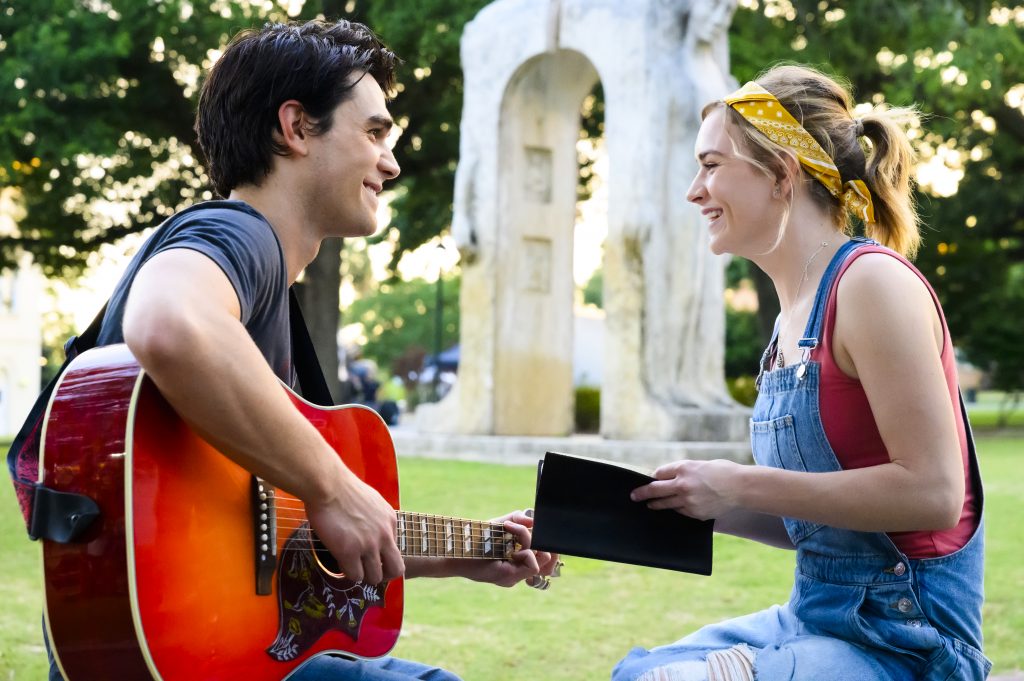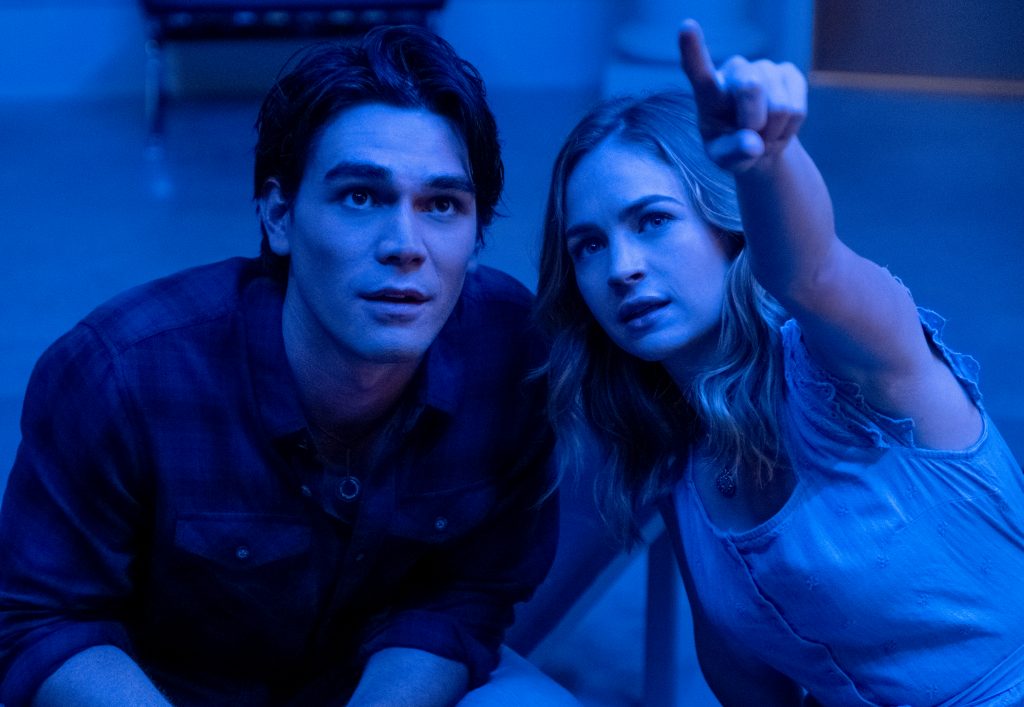March 13, 2020
by Carla Hay

Directed by Jon Erwin and Andrew Erwin (The Erwin Brothers)
Culture Representation: Taking place mostly in California and partially in Indiana, the faith-based drama “I Still Believe” has almost an exclusively white cast representing the middle-class (with a few African and Latinos in minor speaking roles) and has a story based on the real-life contemporary Christian singer Jeremy Camp at the beginning of his career.
Culture Clash: During his first year in college, Jeremy gets involved in a love triangle with a young woman who finds out that she has cancer.
Culture Audience: This movie will appeal mostly to fans of Jeremy Camp and anyone who likes predictable, tear-jerking, faith-based movies.

Bring on the Christian melodrama. “I Still Believe,” which tells the story of how real-life contemporary Christian singer Jeremy Camp met and fell in love with his first wife Melissa, has enough weepy and sentimental moments to make a Hallmark Channel movie look downright cheerful in comparison. Because this dramatic film is based on true events that fans of Camp already know about (he’s written songs about it and done numerous interviews over the years about this period of time in his life), there really isn’t anything new that will be revealed here for his die-hard fans.
However, for everyone else, there are many indications of how this movie will go, from the cutesy lovebird moments to the emotionally distraught hospital scenes. “I Still Believe” is based on Camp’s 2011 memoir of the same name. Brother directors Jon Erwin and Andrew Erwin directed the movie (they also directed the 2018 biopic “I Can Only Imagine” about MercyMe singer Bart Millard), while Jon Erwin co-wrote the “I Still Believe” screenplay with Jon Gunn.
As the story begins, it’s September 1999 in Lafayette, Indiana (Camp’s hometown), and Jeremy (played winningly by a charismatic KJ Apa) is packing up his car to leave behind his supportive and loving parents and two younger brothers, as he heads off to California to attend college for the first time. (The college isn’t named in the movie, but in real life, Camp attended and graduated from Calvary Chapel Bible College in Murrieta, California.)
Before Jeremy leaves, his parents Tom Camp (played by Gary Sinise) and Teri Camp (played by Shania Twain) give him a brand-new guitar as a gift. They know he’s a talented singer and musician, so they’re encouraging him to use that talent in the best way that he can. (It should be noted that Sinise and Twain are in the movie for only about 20 minutes, since most of the story takes place when Jeremy was a college student in California.)
One of the first things that happens when Jeremy arrives on campus is he meets a personal hero: Jean-Luc (played by Nathan Dean), a French Canadian contemporary Christian singer who graduated from the school years earlier and has returned to do a concert on campus. Because Jean-Luc has “made it” as a successful artist, Jeremy approaches him backstage before the show to tell Jean-Luc how much he admires him and to ask for his career advice.
Jean-Luc tells him the best advice he could give is that being an artist isn’t about “making it” but what an artist’s songs give to people. Jean-Luc also tells Jeremy that songwriting is about authenticity. He confides in Jeremy that he’s been writing love songs lately with a special girl in mind.
To Jeremy’s surprise and delight, Jean-Luc then asks Jeremy to tune his guitar. The next thing you know, Jeremy is an instant guitar tech who gets to go on stage and hand Jean-Luc the guitar when it’s time for Jean-Luc to switch instruments. While giving Jean-Luc the guitar, Jeremy sees a pretty young student in the crowd who seems enraptured as she sings along to the music. And then she and Jeremy lock eyes with each other. It’s a “love at first sight” moment for Jeremy that is as sweetly sentimental as you would imagine it to be.
Jeremy is so smitten that when he sees her hanging out in the theater after the show, he goes up and introduces himself to her. They have a cautiously flirtatious conversation. Her name is Melissa Henning (played by Britt Robertson, in an emotionally believable performance), and she invites Jeremy to hang out with her and some friends at the beach after the show.
It turns out that Melissa is a close friend of Jean-Luc, who’s also there at the beach, to Jeremy’s surprise. Melissa is so close to Jean-Luc that she says that she and Jean-Luc are “best friends.” As Jeremy lets this information sink in (and it becomes obvious that this is the “special girl” that Jean-Luc is writing love songs about), he still tries to figure out a way to date Melissa.
At the beach, Jeremy has brought his guitar, so that’s how Melissa first finds out that he can sing and play. And since she seems to have a thing for musicians, Jeremy’s talent probably makes him even more attractive to her. She plays it cool, but her reaction to him singing and playing shows how much Jeremy has piqued her interest. (Apa does his own singing in the movie. And he’s pretty good.)
When Jeremy is alone with Melissa, he asks her point-blank if she and Jean-Luc are dating. She says no, but she admits that Jean-Luc might have romantic feelings for her that aren’t mutual. Jeremy doesn’t waste time in expressing that he’s available and interested in dating Melissa, but she tells him that she promised God and her protective older sister Heather that this semester that she wouldn’t have any distractions from her studies and that Jeremy is definitely a distraction.
Undeterred, Jeremy persists in asking Melissa out on a date every time he runs into her on campus, until finally she says yes to one date. She agrees on the condition that she and Jeremy see each other in secret because she doesn’t want to hurt Jean-Luc’s feelings.
On their first date, Melissa and Jeremy go to a planetarium. While in the Hubble Space Telescope room, Melissa turns out to be very knowledgeable about astronomy trivia. After she rattles off some facts about outer space, Melissa says, “I’m just one star in an infinite galaxy.” And Jeremy replies as he looks at her meaningfully, “Well, some stars shine brighter than others.” Yes, it’s that kind of movie.
One date turns into two and then into more dates. And soon, it’s obvious that Jeremy and Melissa have fallen in love, but Melissa still wants to keep their relationship a secret because she’s afraid that it will ruin her friendship with Jean-Luc. This deception bothers Jeremy, but he goes along with it because he doesn’t want to lose Melissa.
Meanwhile, Jean-Luc has been acting as a mentor to Jeremy and has even offered to help Jeremy make a demo recording that could lead to a record-label contract. Jean-Luc has also offered to pass along the demo to the right people to help speed up the process. In other words, this love-triangle situation has turned into something even more complicated than when it started.
According to the movie’s production notes, there was no real-life love triangle between Jeremy, Melissa and Jean-Luc, who is based on real-life French Canadian musician Jean-Luc La Joie, the lead singer of the Christian rock band The Kry. In real life, Jean-Luc and Melissa were just friends, and Jean-Luc really did help Jeremy, early on in Jeremy’s career. But the filmmakers decided to make the Jean-Luc character in the movie as a combination of the real person and the numerous guys who were also pursuing Melissa during the time that she and Jeremy began dating.
Whether or not Jean-Luc finds out about the secret love affair turns out to be the least of Jeremy and Melissa’s problems. Just as Jeremy’s career is taking off, Melissa finds out that she has cancer. The rest of the movie shows how this devastating diagnosis affects their relationship. (And if you know what happened in real life, then you already know how this movie is going to end.)
All of the actors do a fine job with their performances. As the central characters in the film, Apa and Robertson (who also played a young couple in love in 2017’s “A Dog’s Purpose”) have natural chemistry together that makes them convincing as two people who’ve fallen hard and fast for each other. But there are moments in the movie that are so melodramatic and cliché-ridden that they’re downright cringeworthy. And there might be some non-religious people who could be offended at the idea that prayer can cause medical miracles. But this isn’t a movie for atheists or people who don’t like Christian movies. “I Still Believe” will definitely be a crowd-pleaser for the film’s intended audience. For everyone else, proceed with caution or avoid the movie altogether.
Lionsgate released “I Still Believe” in U.S. cinemas on March 13, 2020.
UPDATE: Because of the widespread coronavirus-related closures of movie theaters worldwide, Lionsgate Home Entertainment has moved up the digital and VOD release of “I Still Believe” to March 27, 2020.



